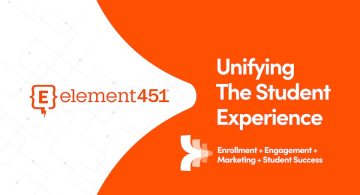Exploring the Power of Student Journey Mapping
by Brandon Hurter · Updated Nov 24, 2024

Colleges and universities are increasingly adopting innovative strategies to improve student engagement, streamline enrollment, and enhance retention. One such transformative approach is student journey mapping.
With tools like Element451’s Journeys, institutions can track and analyze student interactions throughout their journey, providing actionable insights to make data-driven decisions. By mapping the student journey, colleges can better align resources, optimize engagement strategies, and ultimately improve student outcomes.
Understanding the Student Journey
Journeys is a powerful tool that helps institutions track and visualize sequential interactions across the student lifecycle. By combining data from various modules within Element451, institutions can create a holistic view of student engagement, from inquiry to graduation.
Why is this important? Students today expect fast, convenient, and highly personalized experiences. For institutions, having a clear view of how students progress through each stage of their journey isn’t just beneficial for the students—it’s essential for teams supporting them. Mapping these interactions enables institutions to identify bottlenecks, refine processes, and provide the personalized touchpoints students need to succeed.
Breaking Down the Student Journey Mapping Process
Align actions with the student's journey
Mapping the student journey starts with understanding key milestones in the enrollment process. By identifying these points, institutions can trigger actions that provide support and guidance exactly when students need it. For instance, sending a reminder about upcoming deadlines or providing information about campus tours can significantly improve the applicant’s experience.
Regularly review and update actions
Enrollment processes and student needs evolve over time. Regular reviews of actions within the journey ensure that messaging remains relevant. For example, updating email templates to reflect recent institutional achievements or revising workflows to include new virtual engagement options can keep processes fresh and impactful.
Minimize delays in actions
Timeliness is critical in maintaining student engagement. Delays in follow-up communications, such as confirmation emails or financial aid reminders, can cause frustration and disengagement. Institutions should automate these actions using tools like Journeys to ensure prompt and consistent responses.
Leverage cross-platform integrations
To create a holistic view of the student experience, institutions can integrate Journeys with other platforms, such as learning management systems, housing portals, or career services. This enables schools to track a wider range of interactions and provide comprehensive support.
Exploring Element451 Journeys
1. Enhanced visibility and insights
Element451’s Journeys consolidates data into a single dashboard, providing a bird’s-eye view of student interactions. This visibility allows institutions to track progress, spot trends, and make informed decisions. For instance, identifying that a significant number of students abandon applications after starting can prompt schools to simplify their forms or provide better guidance.
2. Customization for varied enrollment processes
Every institution’s workflow is unique, and Journeys adapts to accommodate these differences. Schools can create custom pathways for specific cohorts, such as first-generation students or international applicants, ensuring that all necessary steps are addressed efficiently.
3. Identification of pain points and process improvement
By analyzing journey data, institutions can uncover bottlenecks where students encounter difficulties. For example, if many students fail to complete financial aid applications, schools might introduce targeted workshops or automated reminders to help students through the process.
4. Assessment of marketing efforts
With marketing playing a pivotal role in recruitment, Journeys helps institutions evaluate the performance of campaigns. Tracking metrics like email opens, clicks, and event attendance provides actionable insights to refine strategies and allocate resources effectively.
Benefits of Effective Student Journey Mapping
- Improved Student Experience: Student journey mapping ensures that every interaction meets students’ needs at the right time. By delivering timely and personalized support—such as reminders about scholarship deadlines or registration assistance—students feel more valued and supported, leading to increased satisfaction with the institution.
- Increased Engagement: Personalized messaging, driven by journey data, fosters stronger connections between students and institutions. Tailored communications, such as program-specific updates or invitations to relevant campus events, keep students actively involved and invested in their education journey.
- Actionable Insights for Continuous Improvement: By visualizing where students encounter challenges or disengage, journey mapping provides institutions with clear, actionable data. This enables targeted process refinements, such as simplifying financial aid workflows or enhancing application steps, to improve outcomes.
- Optimized Operational Efficiency: Automating routine processes like follow-up emails or event reminders reduces manual workloads for staff. This efficiency allows teams to focus on high-value tasks, optimizing resource allocation and improving overall productivity.
- Higher Retention and Success Rates: Early identification of challenges—such as students struggling with onboarding or navigating financial aid—enables institutions to intervene proactively. This support reduces dropout rates, ensures students stay on track, and improves overall retention and graduation metrics.
Common Challenges in Student Journey Mapping
- Fragmented Data: When data is siloed across departments, it creates blind spots and prevents institutions from seeing the full student experience.
Solution: Centralize data using an integrated platform like Element451. This ensures all departments—from admissions to financial aid—share insights, enabling a unified and holistic view of student interactions. - Delayed Responses: Slow follow-ups, such as application confirmations or inquiry replies, can disengage students and push them to consider other options.
Solution: Implement automation tools to trigger immediate responses for common actions like application status updates or event registrations, maintaining momentum and interest. - Static Workflows: Inflexible processes that fail to adapt to evolving student preferences, such as virtual communication needs, can hinder engagement.
Solution: Regularly evaluate workflows and update them to include modern features like virtual campus tours, online advising, and personalized digital interactions. - Lack of Personalization: Generic messaging fails to resonate with students who expect tailored communication based on their interests and behaviors.
Solution: Leverage data insights from journey mapping to create segmented and personalized messaging, such as program-specific emails or targeted campaign updates.
By addressing these challenges with thoughtful solutions, institutions can maximize the effectiveness of their student journey mapping efforts and create a seamless, engaging experience for all students.
Mapping the Road to Student Success
Mapping the student journey is vital for colleges and universities looking to improve enrollment processes, boost student engagement, and drive institutional success.
Journeys, with its customizable features and ability to track student interactions, empowers institutions to gain valuable insights into student behavior, make data-driven decisions, and optimize their processes.
By leveraging Journeys effectively, institutions can identify pain points, refine marketing efforts, and ensure timely and relevant actions, ultimately enhancing the student experience and increasing enrollment success.
Frequently Asked Questions (FAQs):
How to design a student journey map?
Start by identifying key stages in the student lifecycle, such as inquiry, application, and enrollment. Map out touchpoints where students interact with your institution, and use tools like Element451 to track progress and refine actions. Ensure touchpoints are personalized, timely, and aligned with student expectations.
What are the stages of student journey mapping?
The stages of student journey mapping align closely with the enrollment funnel:
- Awareness: Students learn about your institution through marketing efforts and events.
- Engagement: Students explore programs and interact with admissions.
- Application: Students submit applications and complete required steps.
- Decision: Students accept offers and prepare for enrollment.
- Retention: Students engage with resources and support services post-enrollment.

About Element451
Boost enrollment, improve engagement, and support students with an AI workforce built for higher ed. Element451 makes personalization scalable and success repeatable.
Categories
New Blog Posts

The Definitive Guide
AI in Higher Education
Bridge the gap between the latest tech advancements and your institution's success.
Useful Links

Talk With Us
Element451 is the only AI Workforce Platform for higher education. Our friendly experts are here to help you explore how Element451 can improve outcomes for your school.
Get a Demo








